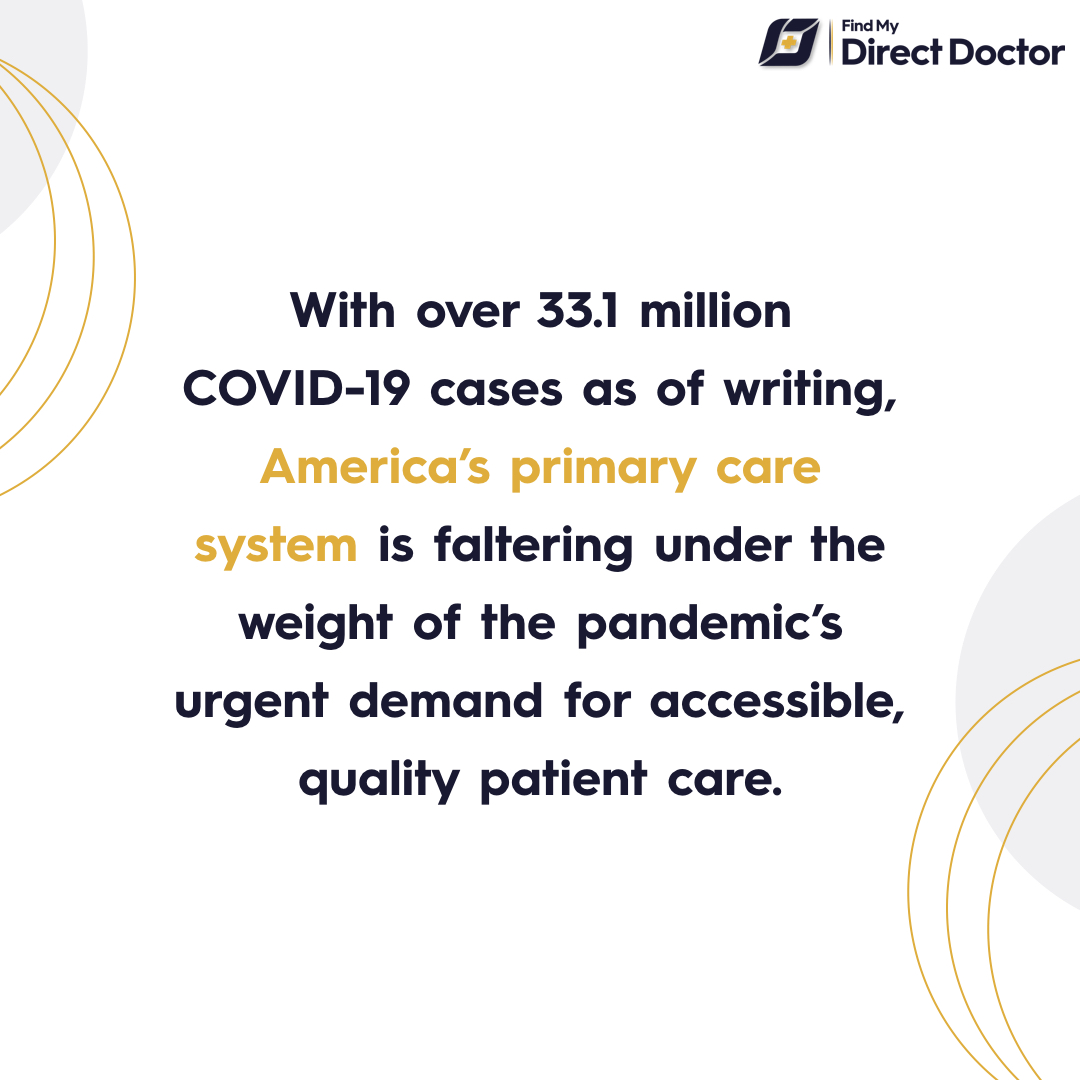



America’s primary care system, which has been looking a little worse for wear way before the pandemic began, is now struggling to make ends meet for patients and doctors alike.
With over 33.1 million COVID-19 cases as of writing, America’s primary care system is faltering under the weight of the pandemic’s urgent demand for accessible, quality patient care. This number yet does not include post-recovery COVID-19 patients– a growing sector of the patient spectrum that also requires significant medical attention these days.
Important insights from the Global Forum on Universal Health Coverage and Primary Health Care say that even though the pandemic response is concentrated on hospital care, only a small percentage of COVID-19 patients are hospitalized. Direct primary care and COVID-19 have become allies, as primary care is at the forefront in managing COVID-related care.
This has left the real contender – primary care – to fend for itself. Primary care continues to carry the bulk of pandemic response in the onset, peak, and recovery of a patient’s battle with COVID-19.
The pandemic has also ushered in a swell in unemployment, shifting patients from employer-sponsored private insurance plans to Medicaid, or worse, no access to health services at all.
Primary care also plays a crucial role in the fight against this global pandemic. As it tends to a wide spectrum of patients, namely those who are suspected of having the virus, those who tested positive for COVID-19, those who are in contact or have been exposed to suspected or confirmed cases, and even recovered patients who continue to feel lingering effects of the virus.
Moreover, a larger percentage of COVID-19 patients exhibit mild to moderate symptoms, which can be treated at home in isolation. No other physician can respond to this type of medical situation better than primary care physicians. The only catch is that fewer doctors choose to be in the primary care practice for many unfortunate reasons.
It is an industry-known fact that primary care physicians in the traditional fee-for-service model are generally underpaid and overworked. Over 50% of traditional primary care physicians exhibit evidence of burnout.
In 2010, there was a shortage of 9,000 primary care physicians and, if no drastic changes were made, the Association of American Medical Colleges (AAMC) anticipated a shortage of 65,800 primary care physicians in the year 2025 – that’s four years from now.
As of 2019, an estimated 14,000 primary care physicians are needed to eliminate existing primary care shortages, per the Kaiser Family Foundation.

Either way, both scenarios are equally alarming because we all know how debilitating the insurance-based, fee-for-service system is to both doctors and patients. The current health care system has made it almost impossible for patients to receive the care and attention they need.
At the height of COVID-19 restrictions, there has been a significant drop in-clinic appointments and the many preventive health services that come along with it. This includes missed vaccinations, irregular diagnostic screenings, and unfulfilled prescriptions.
Dreadful health consequences are born out of not having access to reliable primary care – and medical professionals are quick to remind the public how dire things can get without it.
Major medical studies reveal a direct correlation between consistent access to primary care and less ER trips and hospital confinement, lower health care expenses, and positive health outcomes in the long term.
While the pandemic has undoubtedly worsened the shortage of primary care in the country, it has forced the health care industry to develop creative solutions to adapt to the demand for quality, convenient primary care.
The presence of membership-based models such as Direct Primary Care and Concierge Medicine has been especially important in steering the nation’s primary care crisis to a more positive direction.
Without the intervention of intermediaries like insurance companies and corporate hospitals, Direct Primary Care physicians and Concierge doctors no longer have to succumb to the fee-for-service model where compensation favors repetitive, sometimes borderline unnecessary, medical episodes over routine, preventive treatment.
Membership-based models have also given rise to priceless benefits such as telemedicine, affordable outpatient services and medication, and unrestricted access to your primary care physician – services that have become significant weapons in the fight against the pandemic.
This pandemic has pushed America’s primary care crisis to the brink, to many brinks.
Not only are these new health care models addressing the primary care demands of the pandemic, but they have also begun to reshape America’s medical systems at the core.
Seeing your doctor now-a-days does not necessarily mean paying them a visit at their clinic; it can also mean a quick phone call, a video chat conference, an exchange of text messages, whatever is most convenient for the patient at that moment.
The pandemic has revealed how faulty and flimsy America’s insurance-based, fee-for-service health care system really is, and yet it has also revealed an opportunity to finally restructure the system based on the best interests of the industry’s stakeholders: the physicians and their patients.
From a medical perspective, the light at the end of this primary care-slash-pandemic horror tunnel comes in the form of the public realizing the value of counseling vs. hospital confinement, of education vs. ER trips, and preventive disease management vs. paralyzing medical expenses.
This we are placing our bets on: pushing new and improved health care systems into public consciousness and overhauling existing financial schemes to adapt to first-class patient care could be America’s stronghold against any future health care crisis or (knock on wood) maybe even another pandemic.
Search for a primary care physician near me and experience everything that primary care has to offer in your area.